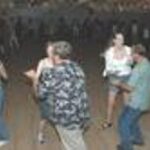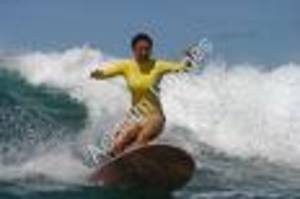I hate exercising. No, really, I do – I loathe it, in fact. I start out with the best of intentions and think, “Well, maybe if I just had the right equipment to inspire myself…”
Under my desk – the one I’m currently sitting at – is a thigh press type thing, all encased in red foamy material that’s safely covered with a layer of dust. In my bedroom closet is an ab roller, one of those little things that help you do crunches. I also have a really inspiring collection of dvd’s that teach how to do kickboxing, yoga, and tai chi. Somewhere around here is a fitness ball that’s still in its box, and I’m sure that’s where I hid the book with dvd that shows how to use it.
Right … so I have no motivation to exercise. If it seems like exercise, my mind creates this overwhelming disgust for the entire thing. I can do yoga when I need to relax, but only as long as it makes me relax and doesn’t make me think I’m warming up for something serious. Kickboxing worked out for about six months, only because the woman teaching it was so irritatingly, perfectly built that I could easily imagine doing her damage with the moves she taught. Awful, I know, but at least that was some kind of motivation.
Every Saturday is cleaning day. I load up several albums on my computer, crank the speakers, and get the kid moving along with me to get the house all prepared for the hurricane (if you have children, you know what I mean) that will ensue. So while I was cleaning a couple of Saturdays ago, I realized that I was happily grooving along to the music – sweating away, and smiling while I cleaned house. Weird, right? The more I thought about it, though, the more I remembered the rush that dancing of any sort has always given me. The feeling of just moving – gliding, turning, or quick and fast-paced … it doesn’t matter, if I’m moving to the music, I’m happy.
Six years after having my daughter, I’ve still not lost the baby-weight. Not too surprising, after everything I’ve just said, but it’s something that weighs heavily (no pun intended) on my mind. My family has a high tendency toward diabetes and heart disease, two diseases which are thought to be caused or worsened by obesity. There’s no way I’m going down that road, so I have sought hard for something I can do to exercise, lose some of the baby-weight, and do it without groaning in horror every day.
My little cleaning episode sent me on a search: Dance as Exercise. Surely I’m not the first person to think of this, I told myself, as I searched the digital aisles of Amazon and Barnes & Noble. I found several good candidates on eBay, but not something that contained routines – a full workout that was nothing but dance.
What I finally found was a book that is currently making my life … well, changed in positive ways: “Alvin Ailey Dance Moves! – A New Way to Exercise”.
The Idea Behind the Dance Moves!
With rave reviews from The New Yorker and The New York Times, Newsday, and many other publications, I couldn’t help looking more into the “Alvin Ailey” of the book before I nudged myself towards spending the money on it. What I came up with was encouraging: Alvin Ailey American Dance Theater is currently recognized as one of the most prestigious modern dance companies in the world. Their dancers are trained in a variety of movements that develop truly versatile, strong, and beautifully toned bodies.
Within the book, author Lise Friedman works right alongside Alvin Ailey’s dancers to demonstrate in beautiful, full-color photography, the disciplines taught at the Ailey School. Modern dance, classical ballet, West African and Indian dance right into yoga poses are all represented. Because of the way these skills are taught, you don’t have to know a single thing about dance in order to improve your posture, increase your strength, stamina, flexibility and muscle tone. Each of these things, in turn, translate into fewer aches and pains (your muscles are stronger, putting less stress on parts of your body like your back to carry your frame), and a greater sense of well-being and ability to relax.
All this was cool, and really encouraging, but it isn’t what “sold” me. What did that was the fact that this book contains a series of exercises that are grouped by benefits, meaning that you never have to do the same routine more than 1 day in a row if you don’t want to. The shortest program takes only 10 minutes, so I can fit it in between running the kid to school and preparing my own lunch.
In other words, the book alone will help you (I’m proof, as I’ve not yet run away) approach exercise from the standpoint of fun. You can crank whatever tunes inspire you to groove, and start ticking away through the movements. As you get used to the movements that you like best, you will always have your fitness routine “at hand” – there’s no equipment to take with you, and every hotel has electric plugs for you to tap a stereo into.
Beyond Dance Moves!
There’s certainly no reason that you should have to rely on a book to incorporate (or use only) dance as your form of exercise. I am, quite obviously and self-admittedly, an Internet Addict. Simple enough, though, for anyone to hit Google and search for “Dance Routines” or “Learn to Dance”.
If you want to approach dance as fitness this way, though, make sure that you pay attention to the following areas and incorporate appropriate movements for each area into your routines:
1. Warm-Up: No matter what kind of fitness you’re doing, you should always begin with a warm-up. Gentle, slow-paced stretches, neck-rolls, and breathing exercises fit in here. There is not a respectable or well-designed exercise routine in the world that won’t begin with a warm-up first. This essential step gets your blood moving so that it can warm and coordinate your muscles, preparing them to work without causing you stress or injury. A warm-up routine will also help you focus your mind on the task at hand, getting you mentally prepared for the more physical exercise to follow.
2. Posture & Alignment: If you’re paying attention, you can spot a dancer in any crowd of people. They carry themselves in a way that stands out – their posture is striking, elegant. The sense of confidence that a dancer radiates doesn’t come without reason: having good posture has health benefits. When you slouch, your back and stomach muscles weaken which affects your energy levels – you’re unable to breathe properly, and you strain your neck, shoulders, lower back, knees and feet. Poor posture also speaks volumes to onlookers about your self-confidence. Movements that help incredibly with posture come from yoga and ballet. Try yoga “lumbar alignment” techniques, abdominal lifts, and ballet movements like the Port de Bras.
3. Stretching: Not only can stretches be beneficial during the warm-up phase of your routine, but they can also help you improve your strength and stamina. Taking time to focus specifically on stretches outside of the warm-up further prepares your body for movement, increases your natural range of motion, and releases muscular tension from fatigue and overuse. Longer, looser muscles developed from taking time to practice stretching are also more flexible, which means that they’re much less likely to be injured. When you perform stretches, though, do not force your muscles. It’s not just painful, but it can do the exact opposite of what stretches are intended to and cause you a nasty injury. Instead, relax with a deep breath, hold your stretch for a few seconds, and if it starts to hurt, ease up.
4. Strength: True bodily strength goes beyond the ability to lift heavy weights. A strong body is able to endure, it contains power and control. The bulky muscles of a bodybuilder aren’t developed by dancers; instead, the more elegant, streamlined look of muscles that have gained their strength from movement are what dancers achieve. Each and every muscle uses the weight and force of the body to work against the push and pull of gravity, creating a body that will resist exhaustion and injury. Ab rolls, crunches, gluteal squeezes, push-ups, and even ballet movements like the plie fall under the strength portion of your routine.
5. Balance & Coordination: After the first four areas in your routine, your mind is sharpened, ready for more fine-tuned tasks. This is where you develop actual dance techniques, movements that are perfectly usable in a full-on dance routine. After stretching, your muscles are ready to match a beat and with your posture aligned, you’ll be more awake and energized. Pay particular attention to the way that your body reacts to the movements that you do now, the difference that a slight shift of weight to a different foot causes the rest of your body to move. Each and every muscle in your body is alive, vital and ready to become stronger … help it get there by listening to what your body has to say. Specific balancing techniques are perfect, as are dance steps like the box step, and lunges.
Once you’ve made your way through these 5 vital areas, you’re ready for the cool-down. Essentially, a cool-down is the same as a warm-up … but slower, more relaxed. You want to ease your breathing back to normal, slowing your heart rate, and letting your muscles realize that it’s time to take it easy.
So what are you waiting for? Pile some new music on your headset and get moving.
Reference:
- Alvin Ailey Dance Moves! – On Amazon.com, you can grab the book that gave me such inspiration for a great price – www.amazon.com/gp/product/B000E97X5C/002-6961464-2036012?v=glance&n;=283155Active Videos – A page with dozens of dvd’s that address Dance Fitness. Everything from the Dance Hoop Workout to bellydance. www.activevideos.com/dancefitness.htmDance Forums – A site that’s dedicated to dance in all its many facets, with links to places where you can learn specific dance moves, read articles, and post your own questions and/or advice. www.dance-forums.com/index.php




